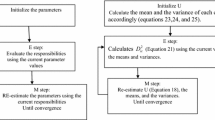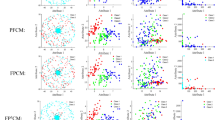Abstract
Clustering analysis is an important topic in artificial intelligence, data mining and pattern recognition research. Conventional clustering algorithms, for instance, the famous Fuzzy C-means clustering algorithm (FCM), assume that all the attributes are equally relevant to all the clusters. However in most domains, especially for high-dimensional dataset, some attributes are irrelevant, and some relevant ones are less important than others with respect to a specific class. In this paper, such imbalances between the attributes are considered and a new weighted fuzzy kernel-clustering algorithm (WFKCA) is presented. WFKCA performs clustering in a kernel feature space mapped by mercer kernels. Compared with the conventional hard kernel-clustering algorithm, WFKCA can yield the meaningful prototypes (cluster centers) of the clusters. Numerical convergence properties of WFKCA are also discussed. For in-depth studies, WFKCA is extended to WFKCA2, which has been demonstrated as a useful tool for clustering incomplete data. Numerical examples demonstrate the effectiveness of the new WFKCA algorithm
Similar content being viewed by others
References
Bezdek JC (1981) Pattern recognition with fuzzy objective function algorithms. Plenum Press, New York
Bezdek JC (1980) A convergence theorem for the fuzzy ISODATA clustering algorithms. IEEE Trans Pattern Anal Mach Intell 2:1–8
Dempster AP, Laird NM, Rubin DB (1977) Maximum likelihood from incomplete data via the EM algorithm. J R Stat Soc Ser 39:1–38
Duda RO, Hart PE (1973) Pattern classiacation and scene analysis. Wiley, New York
Elaine YC, Wai KC (2004) An optimization algorithm for clustering using weighted dissimilarity measures. Pattern Recognit 37:943–952
Frigui H, Nasraoui O (2004) Unsupervised learning of prototypes and attribute weights. Pattern Recognit 37:567–581
Gary K, Honaker J, Joseph A, Scheve K (2000) Listwise deletion is evil: what to do about missing data in political science. http://Gking.Harvard.edu
Girolami M (2002) Mercer kernel-based clustering in feature space. IEEE Trans Neural Netw 13:780–784
Gordon AD, Henderson JT (1977) An algorithm for Euclidean sum-of-squares classification. Biometrics 33:355–362
Han JW, Kamber M (2000) Data mining: concept and techniques. Morgan Kanfmann, San Mateo
Hathaway RJ, Bezdek JC (2001) Fuzzy c-means clustering of incomplete data. IEEE T Sys Man Cybern B: Cybern 31:735–744
Hopper F (1999) Fuzzy cluster analysis. John Wiley, Chichester
Leski J (2003) Towards a robust fuzzy clustering. Fuzzy Sets Syst 137:215–233
Little RJ, Rubin DB (1987) Statistical analysis with missing data. Wiley, New York
Myrtveit I, Stensrud E, Olsson UH (2001) Analyzing data sets with missing data: an empirical evaluation of imputation methods and likelihood-based methods. IEEE Trans Softw Eng 27:999–1013
Pedrycz W (2001) Fuzzy equalization in the construction of fuzzy sets. Fuzzy Sets Syst 119:329–335
Portes M (2004) Image thresholding using Tsallis entropy. Pattern Recognit Lett 25:1059–1065
Roth V, Steinhage V (1999) Nonlinear discriminant analysis using kernel functions. In: Solla SA, Leen TK, Muller K-R (eds) Advances in neural information processing systems. MIT Press, Cambridge, pp 568–574
Shen HB, Wang ST (2004) Fuzzy kernel clustering with outliers. J Softw 15:1021–1029 (in Chinese with English abstract)
Vapnik VN (1998) Statistical learning theory. Wiley, New York
Wang Q, Chi ZR (2002) Image thresholding by maximizing the index of nonfuzziness of the 2-D grayscale histogram. Comput Vis Image Underst 85:100–116
Wang K, Lu WC, Chen NY (2004) Investigation of Ru-porcelain of song dynasty by trace element-SVM method. Comput Appl Chem 21:191–194 (in Chinese with English abstract)
Wang ST, Chung KF, Shen HB (2004) Note on the relationship between probabilistic and fuzzy clustering. Soft Comput 8:366–369
Wu KL, Yang MS (2002) Alternative c-means clustering algorithms. Pattern Recognit 35:2267–2278
Yeung DS, Wang XZ (2002) Improving performance of similarity-based clustering by feature weight learning. IEEE Trans PAMI 24:556–561
Yu J, Cheng QS, Huang HK (2002) Analysis of the weighting exponent in the FCM. IEEE Trans Syst Man Cybern B 34:634–639
Zhang L, Da ZW, Jiao LC (2002) Kernel clustering algorithm. Chinese J Comput 25:587–590
Author information
Authors and Affiliations
Corresponding author
Rights and permissions
About this article
Cite this article
Shen, H., Yang, J., Wang, S. et al. Attribute weighted mercer kernel based fuzzy clustering algorithm for general non-spherical datasets. Soft Comput 10, 1061–1073 (2006). https://doi.org/10.1007/s00500-005-0043-5
Published:
Issue Date:
DOI: https://doi.org/10.1007/s00500-005-0043-5




